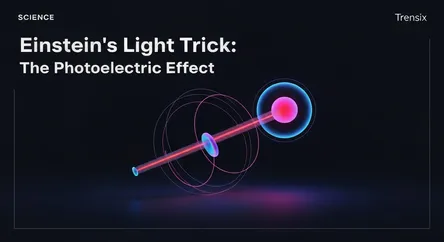Science
Einstein's Light Trick: The Photoelectric Effect

Discover the photoelectric effect, the phenomenon where light creates electricity, a cornerstone of quantum mechanics and the basis for solar panels.
What is it?
The photoelectric effect is the emission of electrons from a material when light shines on it. First observed by Heinrich Hertz in 1887, the effect couldn't be explained by classical physics, which viewed light as a wave. In 1905, Albert Einstein proposed a revolutionary explanation that light consists of discrete energy packets called photons. When a photon strikes a material, it can transfer its energy to an electron. If this energy is sufficient to overcome the forces binding the electron to the material (the work function), the electron is ejected. Einstein's explanation was a pivotal moment in physics, earning him the 1921 Nobel Prize and laying the groundwork for quantum mechanics and the concept of wave-particle duality.
Why is it trending?
While a foundational concept, the photoelectric effect is at the heart of renewed scientific inquiry. Researchers are using advanced tools, such as ultra-fast attosecond X-ray pulses, to probe the phenomenon on incredibly short timescales, revealing new details about electron dynamics that were previously unobservable. These studies are not just refining a century-old theory but are providing deeper insights into electron-electron interactions, which are fundamental to semiconductors and solar cells. Furthermore, recent experiments with specific materials have revealed unexpected photoemission properties that challenge current theoretical frameworks, opening new avenues for research in materials science.
How does it affect people?
The photoelectric effect is fundamental to many technologies that shape modern life. Its most well-known application is in photovoltaic cells, or solar panels, which convert sunlight directly into electricity. It is also the principle behind the light sensors in digital cameras (CCDs and CMOS sensors) that capture images by converting light into electrical signals. You encounter this effect in everyday devices like automatic door openers, barcode scanners, and some types of smoke detectors. In science and medicine, it's used in photomultiplier tubes to detect faint light in astronomy, in X-ray photoelectron spectroscopy (XPS) for material analysis, and in medical imaging technologies like CAT scans.